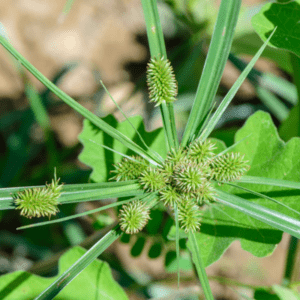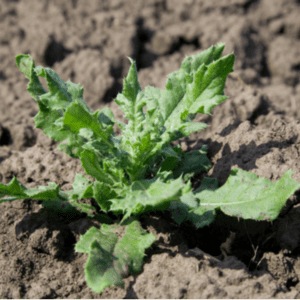It’s finally time to ditch the winter coats for light jackets, break out the garden hose, and tune up the lawnmower. Unfortunately, with the arrival of that lush spring lawn also comes many unwanted weeds. Learn how to identify the usual suspects that love to plague our Cincinnati lawns. 
Early Spring Weeds
Sedge
Also known as nutsedge, this weed is very aggressive. They look similar to regular turfgrass, making it difficult to identify them until the weed is well-established in your lawn. This weed comes in both a purple and yellow-flower variety. Mechanical control methods, i.e., digging, will need to reach depths of 10 inches and eight to ten inches in diameter away from the plant to ensure the root system is completely gone.
Crabgrass
This is a term that actually refers to a genus of both annuals and perennials. Crabgrass is spread by seeds, so it’s easier to control than the other spring weeds we’ve discussed. The tricky thing about crabgrass is due to the fact that it grows low to the ground in circular patches. Consequently, it is often missed by the blades of your mower. And because the stalks aren’t as rigid as other weed species, it isn’t likely to break or snap off due to foot traffic. The best way to eradicate crabgrass is to dig it out with a trowel if you’ve only got a small infestation, or, better still, enlist the help of a good herbicide.
Dandelions
Regarded as a pest for many decades, there are some out there who enjoy the taste of dandelion wine, and some folks even use it in salads. However, if you’re like most Americans, you’re likely, not happy to see these iconic yellow flowers on your lawn. Aside from their characteristic flowers, which later turn into white puffs to make wishes on, you can identify this weed by its leaves. Thick and green, their leaves are jagged around the edges. Interestingly, these jagged leaves are where they get their name. The French phrase “‘dent de lion” or “lion’s tooth” refers to the jagged edge of the plants’ leaves. Dandelions typically flower in April and May, but it can be one of the early spring weeds to emerge. Depending on weather conditions, it has been recorded as early as February. Like many weeds, Dandelions need lots of direct light to thrive, so one of the easiest ways to combat the plant – apart from herbicide – is to make sure you’re not cutting the grass too close to the ground. Keeping your mower at a good height will prevent weeds from getting much-needed sunlight.
Plantain
This broadleaf weed is a common scourge of Ohio lawns. The leaves are large and oval in appearance with ribbed edges and small flowers that grow in clusters. Because it grows so close to the ground, plantain is difficult to eradicate even through mowing the lawn. However, a good weed control spray will make quick work of this plant since it mainly reproduces through seed distribution – not through its root system.
Thistle
Also known as “bull thistle,” this is a biennial plant that produces the characteristic purple flower. The leaves appear hairy and irregular  around the edges. These weeds are hardy, and the rosettes will continue growing even during the winter. These weeds can be quite large – as big as three feet – and removing fully-grown plants can be tricky as they have many spikes. However, they mainly reproduce through seeds, so, like the plantain, they are not as difficult to eradicate as those that reproduce via the root system.
around the edges. These weeds are hardy, and the rosettes will continue growing even during the winter. These weeds can be quite large – as big as three feet – and removing fully-grown plants can be tricky as they have many spikes. However, they mainly reproduce through seeds, so, like the plantain, they are not as difficult to eradicate as those that reproduce via the root system.
Get The Best Weed Control In Cincinnati – Call Turf Pro Plus Inc
Don’t let springtime weeds overrun your beautiful lawn! The experts at Turf Pro Plus Inc! Our weed control program targets the most common Ohio weeds to stop new ones from germinating and existing ones from re-growing. Take back control of your lawn today! Call 513-545-6295 or contact us online here.